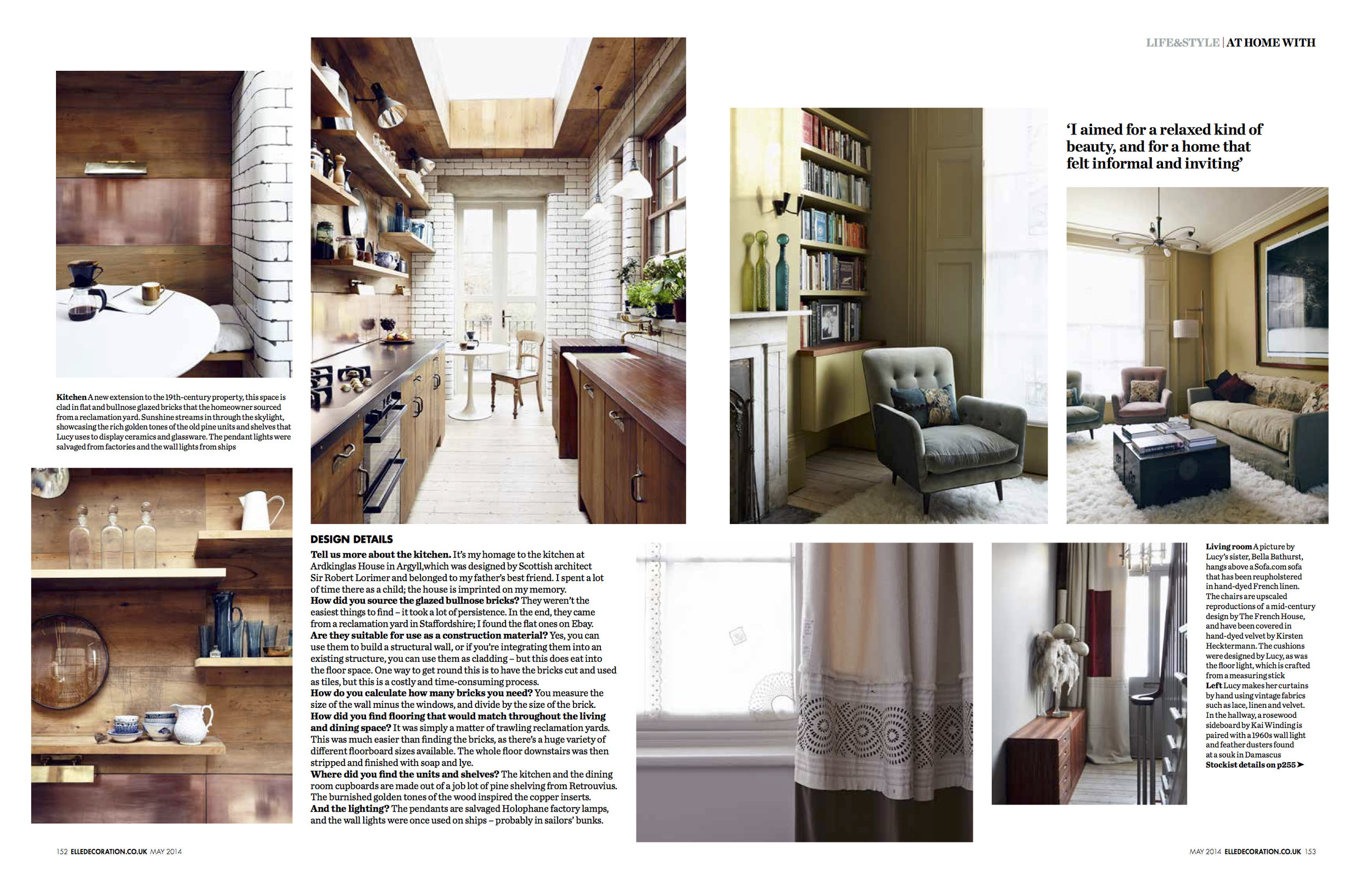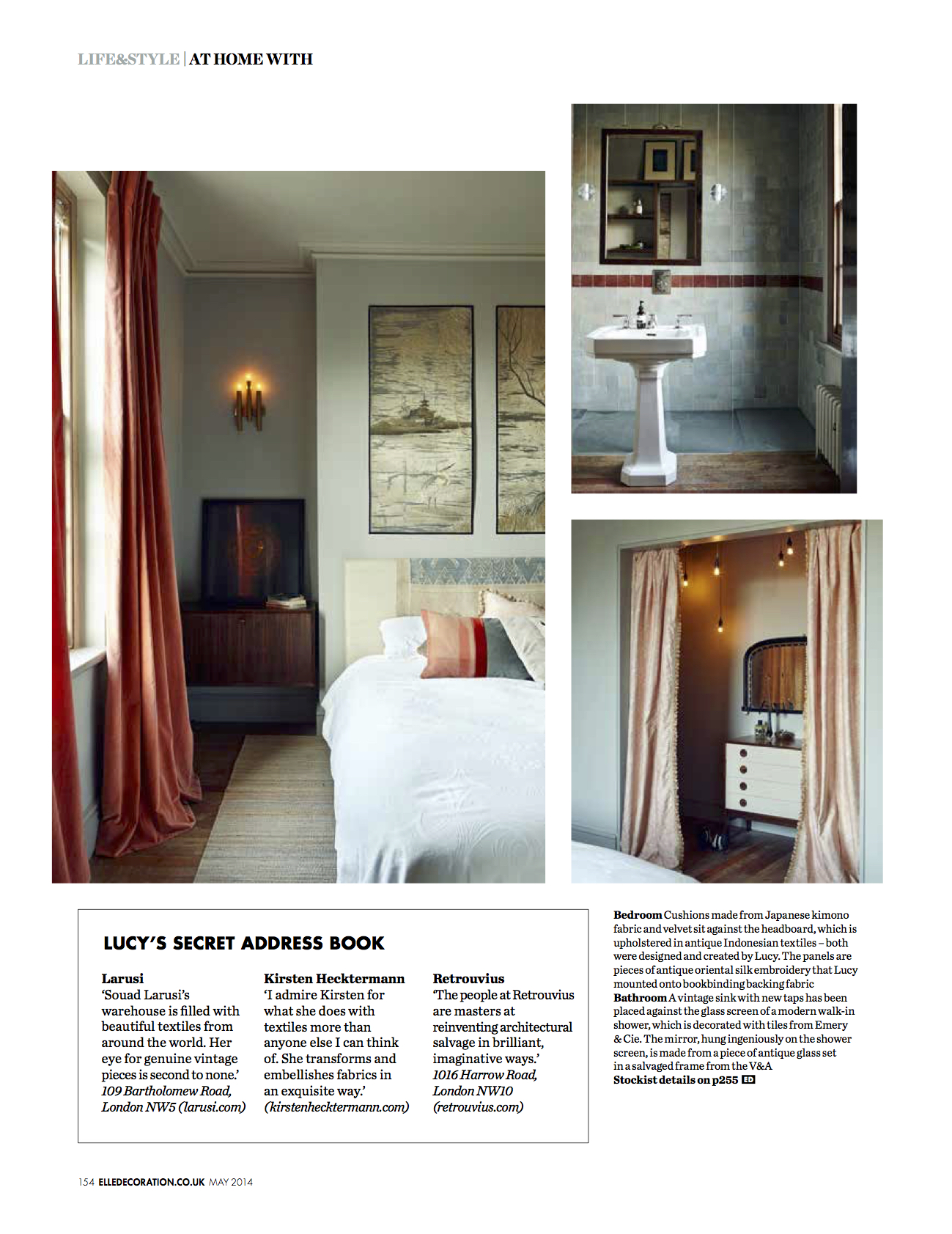Lucy Bathurst
ELLE DECORATION // MAY 2014



SALVAGE OPERATION
With an interior created largely from reclaimed materials, designer Lucy Bathurst’s East London home mixes industrial elements and antique textiles for a relaxed yet graceful effect
Words/Production TESSA PEARSON Photography JAKE CURTIS
British designer-maker Lucy Bathurst found her calling while working on an extensive restoration project in India. Then a curtain maker, she’d been drafted in to help fix up the interior of a vast, crumbling Indian palace in Hyderabad, and while doing so, she discovered a passion for antique fabrics. Now, Lucy collaborates with London-based architects and salvage experts Retrouvius, transforming vintage textiles into bespoke creations. ‘It’s so satisfying to see old or discarded materials used in a contemporary context,’ she says. ‘You can take something tired and make it sing again if you reinterpret it in the right way.’
This resourceful ethos is reflected in the interior of her 19th-century home in East London, in which industrial salvage is mixed inventively with antique finds and Lucy’s textile designs. A utilitarian kitchen made from old pine, copper panels, slate and reclaimed glazed bricks complements the muted greys and earthy olive tones of the open-plan living and dining area. Lucy’s handmade lace and linen curtains soften the scheme, filtering the light that pours in through the large Victorian sash windows. A slouchy sofa and a flokati rug add warmth and offset the sober, Dutch Master-style moodiness of the dining space.
The feel of unpolished elegance continues upstairs, where hand-dyed velvet, restored oriental textiles, mid-century furniture and atmospheric lighting create an air of bygone glamour. The juxtaposition of humble materials with luxurious touches is key to Lucy’s style. This contrast is seen in the two bathrooms: one has a wall of shimmering blue-grey tiles from Emery & Cie; the other is clad in teak floorboards and features an Edwardian poultry incubator as a basin unit. Lucy’s fascination with clean lines and craftsmanship ties the space together. ‘I’m not at all precious. My dog walks through the house every day with muddy paws,’ she admits. ‘I aimed for a relaxed kind of beauty – a home that feels informal and inviting.’ nestdesign.co.uk
DESIGN DETAILS
Tell us more about the kitchen. It’s my homage to the kitchen at Ardkinglas House in Argyll,which was designed by Scottish architectSir Robert Lorimer and belonged to my father’s best friend. I spent a lotof time there as a child; the house is imprinted on my memory.
How did you source the glazed bullnose bricks? They weren’t the easiest things to find – it took a lot of persistence. In the end, they came from a reclamation yard in Staffordshire; I found the flat ones on Ebay.
Are they suitable for use as a construction material? Yes, you canuse them to build a structural wall, or if you’re integrating them into an existing structure, you can use them as cladding – but this does eat into the floor space. One way to get round this is to have the bricks cut and used as tiles, but this is a costly and time-consuming process.
How do you calculate how many bricks you need? You measure the size of the wall minus the windows, and divide by the size of the brick.
How did you find flooring that would match throughout the living and dining space? It was simply a matter of trawling reclamation yards. This was much easier than finding the bricks, as there’s a huge variety of different floorboard sizes available. The whole floor downstairs was then stripped and finished with soap and lye.
Where did you find the units and shelves? The kitchen and the dining room cupboards are made out of a job lot of pine shelving from Retrouvius. The burnished golden tones of the wood inspired the copper inserts.
And the lighting? The pendants are salvaged Holophane factory lamps, and the wall lights were once used on ships – probably in sailors’ bunks.
LUCY’S SECRET ADDRESS BOOK
Larusi
‘Souad Larusi’s warehouse is filled with beautiful textiles from around the world. Her eye for genuine vintage pieces is second to none.’
109 Bartholomew Road, London NW5 (larusi.com)
Kirsten Hecktermann
‘I admire Kirsten for what she does with textiles more than anyone else I can think of. She transforms and embellishes fabrics in an exquisite way.’
(kirstenhecktermann.com)
Retrouvius
‘The people at Retrouvius are masters at reinventing architectural salvage in brilliant, imaginative ways.’
1016 Harrow Road, London NW10 (retrouvius.com)
ELLE DECORATION